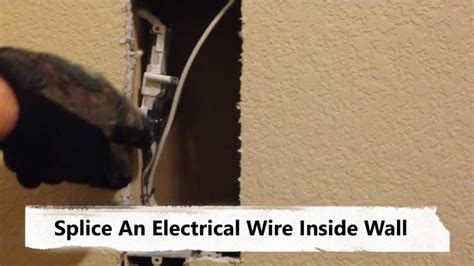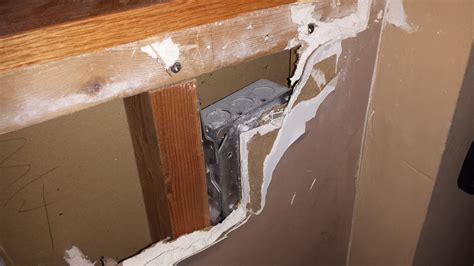can a junction box be covered by drywall If 'it'* has a removable cover and contains any circuit conductors it must not be covered by drywall or and finish. *conduit bodies, other fittings, boxes, wireways etc. There are three junction boxes along the lower lip of this I-Beam that are properly and securely supported with steel beam clamps. No portion of these junction boxes touch any .
0 · splicing wire inside wall
1 · splicing electrical wires behind walls
2 · in wall splice kit legal
3 · hidden junction box in wall
4 · extending romex behind drywall
5 · drywall patch over electrical box
6 · are junction boxes legal
7 · approved in wall wire splice
Discover the critical factors in choosing the right drill bit size for inserting 10 metal screws in DIY metal projects. Unveil the tips for matching drill bit to screw, adjusting for metal thickness, creating pilot holes, testing compatibility, and achieving secure installations.
You cannot cover any junction box that still has live wires in it. Your best bet is to either remove the box all together or just put a cover plate on it.

You are correct, the junction boxes must remain accessible. The NEC 314.29 . If 'it'* has a removable cover and contains any circuit conductors it must not be covered by drywall or and finish. *conduit bodies, other fittings, boxes, wireways etc. No, junction boxes can’t be covered with drywall. It is important to use a proper build method and make sure the joints are sealed properly so moisture cannot get into the box and cause problems. You are correct, the junction boxes must remain accessible. The NEC 314.29 prohibits covering up boxes such that you'd need to remove "part of the building" to access the .
Applying drywall over a junction box is never a good idea. According to the code, your junction boxes should always remain accessible, regardless of how good of a splice you made.The National Electrical Code (NEC) dictates that no wiring splices are allowed outside of an approved enclosure. One type of approved enclosure is a junction box. Junction box covers .
You cannot cover any junction box that still has live wires in it. Your best bet is to either remove the box all together or just put a cover plate on it. It is illegal to put drywall over an electrical outlet or junction box with electrical wires connected or terminated inside the box. If the electrical outlet box is empty or the wire runs through it without terminating, you can cover it with drywall.
If 'it'* has a removable cover and contains any circuit conductors it must not be covered by drywall or and finish. *conduit bodies, other fittings, boxes, wireways etc.
No, junction boxes can’t be covered with drywall. It is important to use a proper build method and make sure the joints are sealed properly so moisture cannot get into the box and cause problems. You are correct, the junction boxes must remain accessible. The NEC 314.29 prohibits covering up boxes such that you'd need to remove "part of the building" to access the wires inside. The drywall is considered "part of the building." Applying drywall over a junction box is never a good idea. According to the code, your junction boxes should always remain accessible, regardless of how good of a splice you made.
The National Electrical Code (NEC) dictates that no wiring splices are allowed outside of an approved enclosure. One type of approved enclosure is a junction box. Junction box covers must remain accessible; they cannot be covered with drywall or other surface material. A junction box covered by a plastic cover is considered identifiable and accessible. A junction box (or worse, a splice hanging in the wall) covered by drywall is not identifiable or accessible. You should never bury a live wire, period. If you’re installing an interior box, use screws or nails to attach the box to a stud, positioned so that the face of the box is flush with the drywall. Exterior boxes should be attached with screws; the back of the box should have small holes for that purpose. As long as there are no wires inside the box, you can cover it with drywall. If the box is still acting as a junction box, however, and wires are joined inside it, the electrical code mandates a removable cover.
You cannot cover any junction box that still has live wires in it. Your best bet is to either remove the box all together or just put a cover plate on it. It is illegal to put drywall over an electrical outlet or junction box with electrical wires connected or terminated inside the box. If the electrical outlet box is empty or the wire runs through it without terminating, you can cover it with drywall. If 'it'* has a removable cover and contains any circuit conductors it must not be covered by drywall or and finish. *conduit bodies, other fittings, boxes, wireways etc. No, junction boxes can’t be covered with drywall. It is important to use a proper build method and make sure the joints are sealed properly so moisture cannot get into the box and cause problems.
You are correct, the junction boxes must remain accessible. The NEC 314.29 prohibits covering up boxes such that you'd need to remove "part of the building" to access the wires inside. The drywall is considered "part of the building." Applying drywall over a junction box is never a good idea. According to the code, your junction boxes should always remain accessible, regardless of how good of a splice you made.
The National Electrical Code (NEC) dictates that no wiring splices are allowed outside of an approved enclosure. One type of approved enclosure is a junction box. Junction box covers must remain accessible; they cannot be covered with drywall or other surface material. A junction box covered by a plastic cover is considered identifiable and accessible. A junction box (or worse, a splice hanging in the wall) covered by drywall is not identifiable or accessible. You should never bury a live wire, period. If you’re installing an interior box, use screws or nails to attach the box to a stud, positioned so that the face of the box is flush with the drywall. Exterior boxes should be attached with screws; the back of the box should have small holes for that purpose.

splicing wire inside wall

steel ute box

Generally, you’ll need a drill bit that’s the same diameter (in millimetres) as the wall plug, but for accuracy, you can drill a pilot hole using a slightly smaller size drill bit first. What size drill bit for red plugs? Most red wall plugs are 6mm in .
can a junction box be covered by drywall|hidden junction box in wall